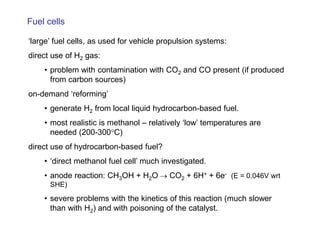This document discusses various topics related to hydrogen as a transport fuel, batteries, and fuel cells. It provides information on:
- Different types of vehicles that use hydrogen or batteries as their fuel/power source
- Methods for producing and storing hydrogen
- How electrochemical cells like batteries and fuel cells work through redox reactions
- Characteristics and reactions of different types of batteries including lead-acid, nickel-cadmium, and lithium-ion batteries.
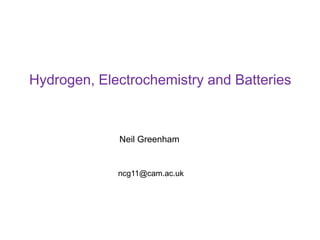


![Making hydrogen
Cheapest production is from methane:
CH4 + H2O → CO + 3H2 (steam reforming) [endothermic ΔH = 192 kJ/mol]
CO + H2O → CO2 + H2 [exothermic, ΔH = -40 kJ/mol]
Note: substantial generation of CO2, problems also with contamination of H2 (especially with CO) so not generally suitable for fuel cells
“There's a lot of hydrogen out there, but it's stuck to other stuff, and it's tough to break it off.” James May, Top Gear
Hydrogen from electrolysis:
H20 → ½O2+2H++2e-
2H+ +2e-→ H2
+ 2 × 1.23eV
Direct photolysis of water?
Biological sources?
more later](https://image.slidesharecdn.com/gtass6zes660mwntwqmx-signature-f45dcaf6c1dd2da490eff6d2593045e4f12d01b0d8bd0e48e22713a0e54cd6c5-poli-141203004617-conversion-gate02/85/Lecture-5-6-Hydrogen-Storage-Batteries-4-320.jpg)


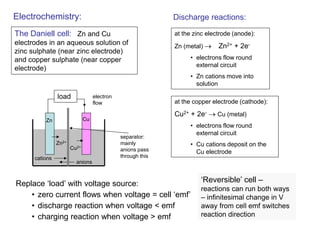

![Standard hydrogen electrode:
platinum metal electrode (with large surface area) dipped into a solution with hydrogen ions at unit ‘activity’ (1 Molar) and in the presence of hydrogen gas at 1 atmosphere.
cell reaction is H2 → 2H+ + 2e-
the ‘SHE’ is taken as the base line for measurement of half-cell potentials – i.e. this sets the SHE to zero potential.
Match to a more familiar energy baseline? the SHE potential lies 4.5 ± 0.1 V below the vacuum level
Ag
Ag+ + e
(i)
Electrochemical oxidation of silver within electrochemical cell. [Measure cell voltage against SHE]
(ii) Photoemission. Minimum photon energy, takes electron from Fermi energy to vacuum level.
ω
Fermi energy
(= highest energy of occupied orbitals)
Vacuum level ω
Connection between SHE ‘zero’ and vacuum level?
(i) and (ii) are not exactly the same – the Ag ion in (i) ends up solvated by e.g. water, but is still on the surface of the Ag electrode in (ii)](https://image.slidesharecdn.com/gtass6zes660mwntwqmx-signature-f45dcaf6c1dd2da490eff6d2593045e4f12d01b0d8bd0e48e22713a0e54cd6c5-poli-141203004617-conversion-gate02/85/Lecture-5-6-Hydrogen-Storage-Batteries-9-320.jpg)




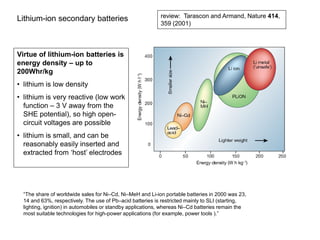
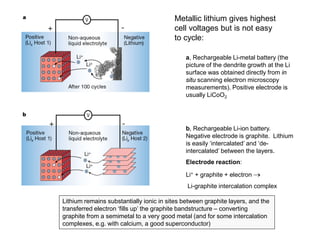

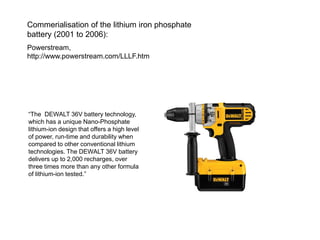
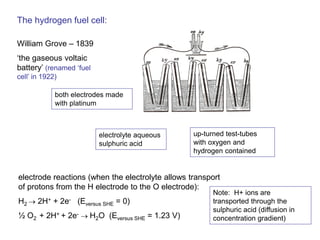
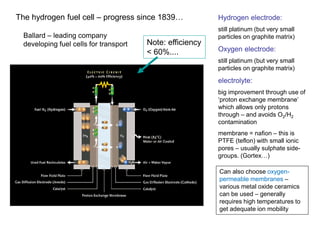

![What holds back fuel cells?
•
the starting components are molecular oxygen and molecular hydrogen
•
the useful electrode reactions only happen after the molecules have dissociated to atomic H and atomic O. At room temperature (and at quite high temperatures), this requires a very effective catalyst. However, the kinetics of this reaction are slow, especially for O2 (1000 times slower than H2)
•
slow kinetics cause reduced output voltage – at usable current densities – typically 0.7 V (c.f. reversible cell voltage of 1.23 V)
•
cf. batteries, designed to charge and discharge much closer to cell voltage
[Note: a catalyst does not change the energy of the reaction, just the kinetics,
by lowering the activation energy for the reaction]
The platinum group elements (e.g. palladium, nickel) are the only known ‘good’
catalysts for dissociation of gaseous molecules – surfaces and interstices of
the lattice are able to absorb atomic species. (Platinum will absorb large
quantities of hydrogen). Platinum group metals are used as catalysts in ‘cat
converters’ on car exhausts, production of ammonia from N2 and H2.]
Not much progress since 1839…?](https://image.slidesharecdn.com/gtass6zes660mwntwqmx-signature-f45dcaf6c1dd2da490eff6d2593045e4f12d01b0d8bd0e48e22713a0e54cd6c5-poli-141203004617-conversion-gate02/85/Lecture-5-6-Hydrogen-Storage-Batteries-21-320.jpg)
